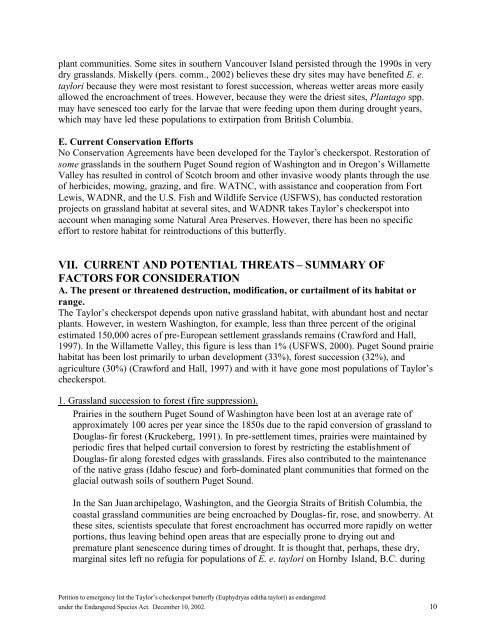petition to emergency list taylor's (whulge) checkerspot - The Xerces ...
petition to emergency list taylor's (whulge) checkerspot - The Xerces ...
petition to emergency list taylor's (whulge) checkerspot - The Xerces ...
Create successful ePaper yourself
Turn your PDF publications into a flip-book with our unique Google optimized e-Paper software.
plant communities. Some sites in southern Vancouver Island persisted through the 1990s in very<br />
dry grasslands. Miskelly (pers. comm., 2002) believes these dry sites may have benefited E. e.<br />
taylori because they were most resistant <strong>to</strong> forest succession, whereas wetter areas more easily<br />
allowed the encroachment of trees. However, because they were the driest sites, Plantago spp.<br />
may have senesced <strong>to</strong>o early for the larvae that were feeding upon them during drought years,<br />
which may have led these populations <strong>to</strong> extirpation from British Columbia.<br />
E. Current Conservation Efforts<br />
No Conservation Agreements have been developed for the Taylor’s <strong>checkerspot</strong>. Res<strong>to</strong>ration of<br />
some grasslands in the southern Puget Sound region of Washing<strong>to</strong>n and in Oregon’s Willamette<br />
Valley has resulted in control of Scotch broom and other invasive woody plants through the use<br />
of herbicides, mowing, grazing, and fire. WATNC, with assistance and cooperation from Fort<br />
Lewis, WADNR, and the U.S. Fish and Wildlife Service (USFWS), has conducted res<strong>to</strong>ration<br />
projects on grassland habitat at several sites, and WADNR takes Taylor’s <strong>checkerspot</strong> in<strong>to</strong><br />
account when managing some Natural Area Preserves. However, there has been no specific<br />
effort <strong>to</strong> res<strong>to</strong>re habitat for reintroductions of this butterfly.<br />
VII. CURRENT AND POTENTIAL THREATS – SUMMARY OF<br />
FACTORS FOR CONSIDERATION<br />
A. <strong>The</strong> present or threatened destruction, modification, or curtailment of its habitat or<br />
range.<br />
<strong>The</strong> Taylor’s <strong>checkerspot</strong> depends upon native grassland habitat, with abundant host and nectar<br />
plants. However, in western Washing<strong>to</strong>n, for example, less than three percent of the original<br />
estimated 150,000 acres of pre-European settlement grasslands remains (Crawford and Hall,<br />
1997). In the Willamette Valley, this figure is less than 1% (USFWS, 2000). Puget Sound prairie<br />
habitat has been lost primarily <strong>to</strong> urban development (33%), forest succession (32%), and<br />
agriculture (30%) (Crawford and Hall, 1997) and with it have gone most populations of Taylor’s<br />
<strong>checkerspot</strong>.<br />
1. Grassland succession <strong>to</strong> forest (fire suppression).<br />
Prairies in the southern Puget Sound of Washing<strong>to</strong>n have been lost at an average rate of<br />
approximately 100 acres per year since the 1850s due <strong>to</strong> the rapid conversion of grassland <strong>to</strong><br />
Douglas-fir forest (Kruckeberg, 1991). In pre-settlement times, prairies were maintained by<br />
periodic fires that helped curtail conversion <strong>to</strong> forest by restricting the establishment of<br />
Douglas-fir along forested edges with grasslands. Fires also contributed <strong>to</strong> the maintenance<br />
of the native grass (Idaho fescue) and forb-dominated plant communities that formed on the<br />
glacial outwash soils of southern Puget Sound.<br />
In the San Juan archipelago, Washing<strong>to</strong>n, and the Georgia Straits of British Columbia, the<br />
coastal grassland communities are being encroached by Douglas-fir, rose, and snowberry. At<br />
these sites, scientists speculate that forest encroachment has occurred more rapidly on wetter<br />
portions, thus leaving behind open areas that are especially prone <strong>to</strong> drying out and<br />
premature plant senescence during times of drought. It is thought that, perhaps, these dry,<br />
marginal sites left no refugia for populations of E. e. taylori on Hornby Island, B.C. during<br />
Petition <strong>to</strong> <strong>emergency</strong> <strong>list</strong> the Taylor’s <strong>checkerspot</strong> butterfly (Euphydryas editha taylori) as endangered<br />
under the Endangered Species Act. December 10, 2002. 10
















